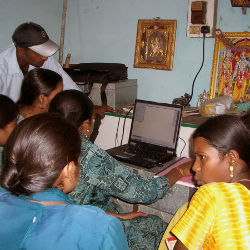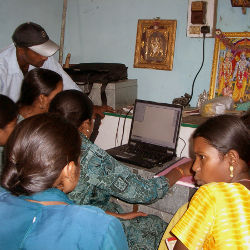
Facebook CEO Mark Zuckerberg echoed the hopes of many when he launched Internet.org to bring more of the world’s population online.2 He said: “The richest 500 million have way more money than the next six billion combined. You solve that by getting everyone online, and into the knowledge economy—by building out the global Internet.”8
But, does giving everyone the Internet really reduce inequality?
Zuckerberg might have been thinking of the economics of diminishing returns, in which technology has a kind of saturation effect—the more of a particular technology you have, the less incremental economic value it contributes. Some economists argue, therefore, that giving developing-world nations a new technology facilitates fast growth, allowing them to catch up with developed countries whose own growth with respect to that technology slows down.1
This may in fact be happening. World Bank economists Christoph Lakner and Branko Milanovic estimate global inequality has declined over the last 20 years,7 a period during which the number of mobile phone accounts worldwide grew so much it almost exceeded the human population.3 Maybe the rapid spread of digital tools is shrinking disparities.
In and of themselves, digital platforms for those with little social and educational capital are meaningless.
More concrete evidence, however, suggests universal connectivity is not the solution to inequality. If anything, digital technologies might aggravate inequalities. Within the U.S., for example, massive open online courses are overwhelmingly completed by college-educated professionals, not jobless high school dropouts.9 The actor/director Zach Braff raised over $3 million through crowdfunding, while the average Kickstarter campaign raises only $6,000.4,6 And over the last four decades, digital technologies penetrated every corner of American life—Google and Facebook became household words, and even homeless people enjoy connectivity at public libraries. Yet, the rate of poverty stagnated, social mobility decreased, and inequality skyrocketed.
There are two reasons why technology dissemination in and of itself does not address inequality. First, the rich can always afford more and better technology. Wealthier people benefit more from innovation because they can afford fancy gadgets and premium services. There is no digital keeping up with the Joneses. Second, eliminating the digital divide does not eliminate socioeconomic divides. Those with better education, more wealth, and greater influence can accomplish more with the same technology. Bill Clinton or Bill Gates could accomplish more than you or I with a week’s unlimited use of the Internet. Similarly, most Communications readers can do more with connectivity than someone in rural Uganda who has not completed primary school.
This is what I call technology’s “Law of Amplification,” and it is exactly what MOOC completion statistics and Braff’s use of Kickstarter bear out. Technology is a tool; it amplifies existing human capacities. This means that if anything, indiscriminate dissemination of digital technology tends to aggravate inequalities. Technology helps only when there is firm intention—economically, politically, culturally—to push against the gradient of inequality.
“Not so fast!” you might say. We cannot know what the U.S. would have been like without Silicon Valley, so we cannot know digital technology’s actual impact with certainty. That is true, but it does not change how we should respond. In any country where there is rising inequality, the possibilities for technology’s role must be one of the following:
- Technology is making inequality worse.
- Technology has little or no effect on inequality, but other forces are increasing inequality.
- Technology is actually alleviating inequality, but other inequality-causing forces are so powerful as to overpower it.
The first two options imply technology cannot solve inequality by itself. The third option might suggest doubling down on technology. But consider again that in the U.S., talented, well-funded entrepreneurs have been working as hard and as fast as they can to churn out new products in a culture that supports them. If tech innovation at full speed is not enough to counter bad socioeconomic forces, maybe those forces need to be addressed directly.
Incidentally, what about the convergence among countries alluded to earlier, the one that causes commentators like New York Times columnist Thomas Friedman to argue “the world is flat”?5 Individuals in developing countries that have a good education, a hefty inheritance, or strong political ties are able to use technology to their advantage and catch up with their developed-world peers. Most of the decline in global inequality is generally attributed to the growth of China and India. But while technology has played a role in their rise as nations, its value is unevenly distributed among their citizens. Digital tools have helped the Indian elite become an IT superpower, but cellphones for India’s undereducated have done little to enrich them. In a country of 1.25 billion people and 900 million mobile accounts, three-quarters of the country still struggles on less than USD$2.50 a day.10 In and of themselves, digital platforms for those with little social and educational capital are meaningless.
I saw this firsthand when I moved to Bangalore in 2004 to start a new research group at Microsoft. I explored how digital tools could support education, agriculture, and healthcare to alleviate poverty. However, projects that worked well as research pilots failed when we tried to scale them up. The problem was that in our research, we could control the social context. But in scaling up, if implementing institutions were ineffective, or if potential beneficiaries lacked basic skills, new gadgetry just did not help. And yet, it was exactly where people were less skilled that we most wanted to provide support. For technology to help the world’s least privileged, it requires exactly the human foundation that is missing to begin with.
So, what is to be done? And more specifically, how can computer scientists concerned about inequality contribute? The Law of Amplification points the way.
First, those already doing something to counter inequality should use technology to amplify their efforts. Indiscriminate dissemination of technology is futile, but targeted use to amplify progressive forces can be effective. For instance, social activists fighting for progressive policy should use whatever communication channels they have available to get their message out. (They should be braced for an ongoing effort, however, because it is their voice, not the technology, which is the primary cause of change.)
Second, those with the proverbial hammer in search of nails should work with good carpenters. The impact of individuals or organizations that are combatting inequality successfully can often be amplified with good technology. Of course, where there aren’t good carpenters, the tools won’t work themselves.
Third, socioeconomic disparities can be addressed directly by helping “have-nots” with education, mentor-ship, funding, and introductions to influential people. Technologists can propagate their own skills and networks, for example, by teaching programming or connecting budding entrepreneurs with seasoned ones. Conversely, giving someone the latest gadget does little in and of itself to help that person close any disparities. A metronome is a useful tool, but it does not make the concert musician.
Finally, all of us can engage the political process as citizens. Technologists often look down on politics, but inequality is a political issue. The computing industry has immense influence, and we can engage in ways beyond the skills of our professional training—just as some already do with political issues that matter to them, such as immigration.
Because technology amplifies human forces, if we ensure social currents are appropriately directed, then all of our amazing technology will work in humanity’s favor.
Figures
 Figure. Digital Green’s video production technique as demonstrated in Jharkhand, India, in 2013. Digital Green produces participatory localized videos for farmers in India, Ethiopia, Ghana, and Afghanistan; http://www.digitalgreen.org/.
Figure. Digital Green’s video production technique as demonstrated in Jharkhand, India, in 2013. Digital Green produces participatory localized videos for farmers in India, Ethiopia, Ghana, and Afghanistan; http://www.digitalgreen.org/.
 Figure. Three boys at a computer literacy training center near Jhansi, India, in 2005.
Figure. Three boys at a computer literacy training center near Jhansi, India, in 2005.
 Figure. A computer literacy class for girls in a low-income community initiated by the author in Bangalore, India, in 2004.
Figure. A computer literacy class for girls in a low-income community initiated by the author in Bangalore, India, in 2004.




Join the Discussion (0)
Become a Member or Sign In to Post a Comment